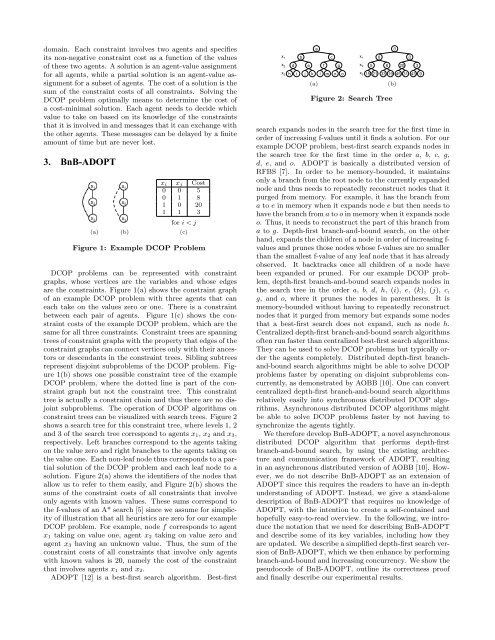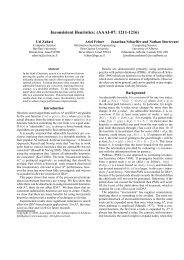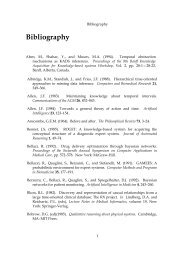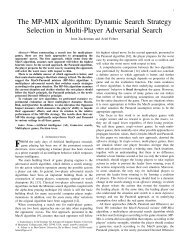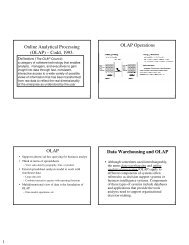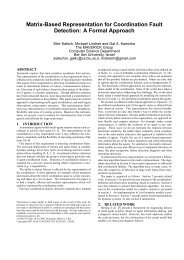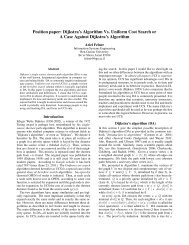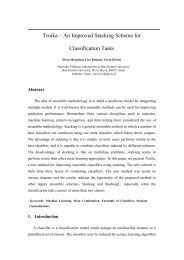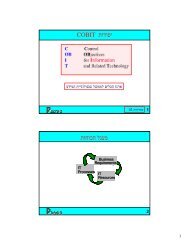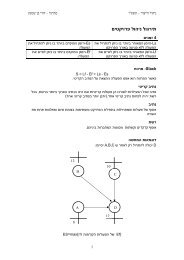BnB-ADOPT: An Asynchronous Branch-and-Bound DCOP Algorithmâ
BnB-ADOPT: An Asynchronous Branch-and-Bound DCOP Algorithmâ
BnB-ADOPT: An Asynchronous Branch-and-Bound DCOP Algorithmâ
You also want an ePaper? Increase the reach of your titles
YUMPU automatically turns print PDFs into web optimized ePapers that Google loves.
domain. Each constraint involves two agents <strong>and</strong> specifies<br />
its non-negative constraint cost as a function of the values<br />
of these two agents. A solution is an agent-value assignment<br />
for all agents, while a partial solution is an agent-value assignment<br />
for a subset of agents. The cost of a solution is the<br />
sum of the constraint costs of all constraints. Solving the<br />
<strong>DCOP</strong> problem optimally means to determine the cost of<br />
a cost-minimal solution. Each agent needs to decide which<br />
value to take on based on its knowledge of the constraints<br />
that it is involved in <strong>and</strong> messages that it can exchange with<br />
the other agents. These messages can be delayed by a finite<br />
amount of time but are never lost.<br />
3. <strong>BnB</strong>-<strong>ADOPT</strong><br />
x i x j Cost<br />
0 0 5<br />
0 1 8<br />
1 0 20<br />
1 1 3<br />
for i < j<br />
(a) (b) (c)<br />
Figure 1: Example <strong>DCOP</strong> Problem<br />
<strong>DCOP</strong> problems can be represented with constraint<br />
graphs, whose vertices are the variables <strong>and</strong> whose edges<br />
are the constraints. Figure 1(a) shows the constraint graph<br />
of an example <strong>DCOP</strong> problem with three agents that can<br />
each take on the values zero or one. There is a constraint<br />
between each pair of agents. Figure 1(c) shows the constraint<br />
costs of the example <strong>DCOP</strong> problem, which are the<br />
same for all three constraints. Constraint trees are spanning<br />
trees of constraint graphs with the property that edges of the<br />
constraint graphs can connect vertices only with their ancestors<br />
or descendants in the constraint trees. Sibling subtrees<br />
represent disjoint subproblems of the <strong>DCOP</strong> problem. Figure<br />
1(b) shows one possible constraint tree of the example<br />
<strong>DCOP</strong> problem, where the dotted line is part of the constraint<br />
graph but not the constraint tree. This constraint<br />
tree is actually a constraint chain <strong>and</strong> thus there are no disjoint<br />
subproblems. The operation of <strong>DCOP</strong> algorithms on<br />
constraint trees can be visualized with search trees. Figure 2<br />
shows a search tree for this constraint tree, where levels 1, 2<br />
<strong>and</strong> 3 of the search tree correspond to agents x 1, x 2 <strong>and</strong> x 3,<br />
respectively. Left branches correspond to the agents taking<br />
on the value zero <strong>and</strong> right branches to the agents taking on<br />
the value one. Each non-leaf node thus corresponds to a partial<br />
solution of the <strong>DCOP</strong> problem <strong>and</strong> each leaf node to a<br />
solution. Figure 2(a) shows the identifiers of the nodes that<br />
allow us to refer to them easily, <strong>and</strong> Figure 2(b) shows the<br />
sums of the constraint costs of all constraints that involve<br />
only agents with known values. These sums correspond to<br />
the f-values of an A* search [5] since we assume for simplicity<br />
of illustration that all heuristics are zero for our example<br />
<strong>DCOP</strong> problem. For example, node f corresponds to agent<br />
x 1 taking on value one, agent x 2 taking on value zero <strong>and</strong><br />
agent x 3 having an unknown value. Thus, the sum of the<br />
constraint costs of all constraints that involve only agents<br />
with known values is 20, namely the cost of the constraint<br />
that involves agents x 1 <strong>and</strong> x 2.<br />
<strong>ADOPT</strong> [12] is a best-first search algorithm. Best-first<br />
x 1<br />
x 2<br />
d<br />
b<br />
e<br />
x 3 h i j k l m n o<br />
a<br />
(a)<br />
f<br />
c<br />
g<br />
x 1<br />
x 2<br />
5<br />
0<br />
8<br />
x 3 15 21 33 19 45 31 43 9<br />
0<br />
(b)<br />
Figure 2: Search Tree<br />
search exp<strong>and</strong>s nodes in the search tree for the first time in<br />
order of increasing f-values until it finds a solution. For our<br />
example <strong>DCOP</strong> problem, best-first search exp<strong>and</strong>s nodes in<br />
the search tree for the first time in the order a, b, c, g,<br />
d, e, <strong>and</strong> o. <strong>ADOPT</strong> is basically a distributed version of<br />
RFBS [7]. In order to be memory-bounded, it maintains<br />
only a branch from the root node to the currently exp<strong>and</strong>ed<br />
node <strong>and</strong> thus needs to repeatedly reconstruct nodes that it<br />
purged from memory. For example, it has the branch from<br />
a to e in memory when it exp<strong>and</strong>s node e but then needs to<br />
have the branch from a to o in memory when it exp<strong>and</strong>s node<br />
o. Thus, it needs to reconstruct the part of this branch from<br />
a to g. Depth-first branch-<strong>and</strong>-bound search, on the other<br />
h<strong>and</strong>, exp<strong>and</strong>s the children of a node in order of increasing f-<br />
values <strong>and</strong> prunes those nodes whose f-values are no smaller<br />
than the smallest f-value of any leaf node that it has already<br />
observed. It backtracks once all children of a node have<br />
been exp<strong>and</strong>ed or pruned. For our example <strong>DCOP</strong> problem,<br />
depth-first branch-<strong>and</strong>-bound search exp<strong>and</strong>s nodes in<br />
the search tree in the order a, b, d, h, (i), e, (k), (j), c,<br />
g, <strong>and</strong> o, where it prunes the nodes in parentheses. It is<br />
memory-bounded without having to repeatedly reconstruct<br />
nodes that it purged from memory but exp<strong>and</strong>s some nodes<br />
that a best-first search does not exp<strong>and</strong>, such as node h.<br />
Centralized depth-first branch-<strong>and</strong>-bound search algorithms<br />
often run faster than centralized best-first search algorithms.<br />
They can be used to solve <strong>DCOP</strong> problems but typically order<br />
the agents completely. Distributed depth-first branch<strong>and</strong>-bound<br />
search algorithms might be able to solve <strong>DCOP</strong><br />
problems faster by operating on disjoint subproblems concurrently,<br />
as demonstrated by AOBB [10]. One can convert<br />
centralized depth-first branch-<strong>and</strong>-bound search algorithms<br />
relatively easily into synchronous distributed <strong>DCOP</strong> algorithms.<br />
<strong>Asynchronous</strong> distributed <strong>DCOP</strong> algorithms might<br />
be able to solve <strong>DCOP</strong> problems faster by not having to<br />
synchronize the agents tightly.<br />
We therefore develop <strong>BnB</strong>-<strong>ADOPT</strong>, a novel asynchronous<br />
distributed <strong>DCOP</strong> algorithm that performs depth-first<br />
branch-<strong>and</strong>-bound search, by using the existing architecture<br />
<strong>and</strong> communication framework of <strong>ADOPT</strong>, resulting<br />
in an asynchronous distributed version of AOBB [10]. However,<br />
we do not describe <strong>BnB</strong>-<strong>ADOPT</strong> as an extension of<br />
<strong>ADOPT</strong> since this requires the readers to have an in-depth<br />
underst<strong>and</strong>ing of <strong>ADOPT</strong>. Instead, we give a st<strong>and</strong>-alone<br />
description of <strong>BnB</strong>-<strong>ADOPT</strong> that requires no knowledge of<br />
<strong>ADOPT</strong>, with the intention to create a self-contained <strong>and</strong><br />
hopefully easy-to-read overview. In the following, we introduce<br />
the notation that we need for describing <strong>BnB</strong>-<strong>ADOPT</strong><br />
<strong>and</strong> describe some of its key variables, including how they<br />
are updated. We describe a simplified depth-first search version<br />
of <strong>BnB</strong>-<strong>ADOPT</strong>, which we then enhance by performing<br />
branch-<strong>and</strong>-bound <strong>and</strong> increasing concurrency. We show the<br />
pseudocode of <strong>BnB</strong>-<strong>ADOPT</strong>, outline its correctness proof<br />
<strong>and</strong> finally describe our experimental results.<br />
20<br />
0<br />
3


